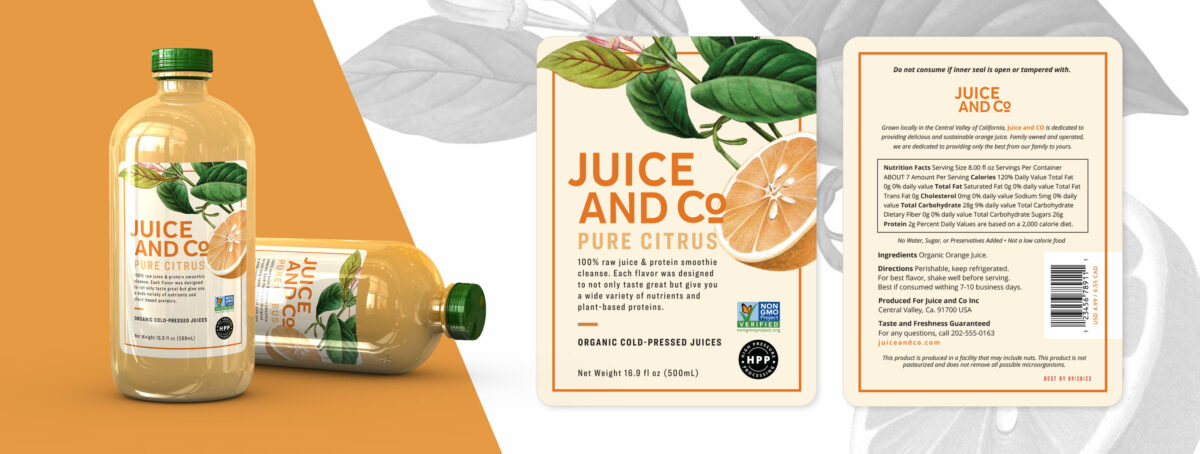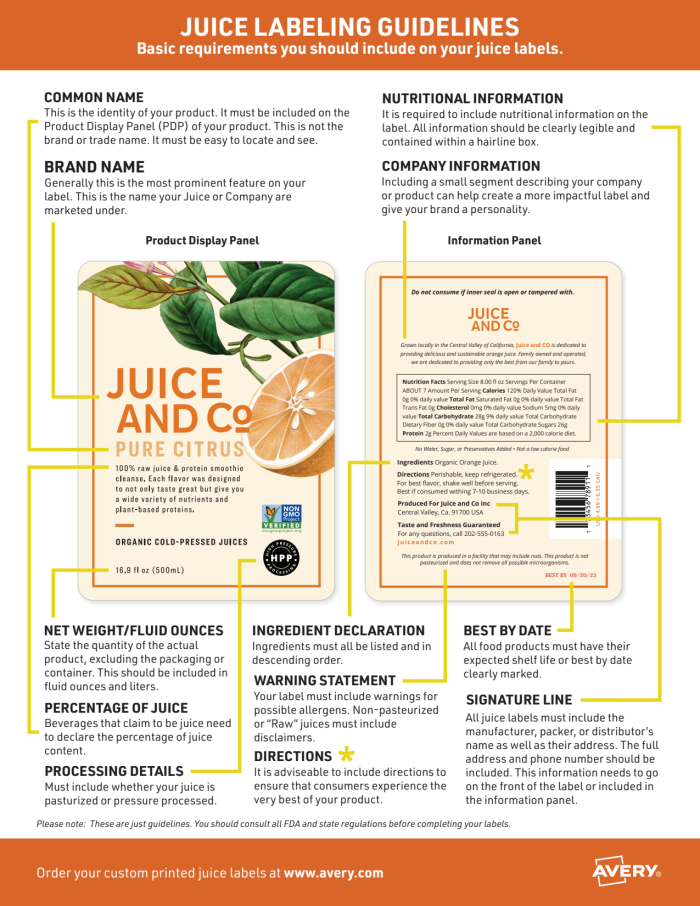Learn how to make labels for juice bottles
Other articles you might like:
All juice bottle labels in the U.S. must adhere to federal regulations. The U.S. Food & Drug Administration (FDA) does not have specific federal legislation so you must follow the FDA legislation for food labels. Consistent, accurate, and clear labeling ensures that the products are not adulterated or misbranded. It will also enhance the consumers’ ability to make an informed choice.
In this article, we’ve put together an easy-to-read guide on what you must include on your juice bottle labels and other items that are good to have. We also included this handy PDF that you can print out.
What to include on your PDP label
1. Common name
This is what your product is – juice. It must be included on the Product Display Panel (PDP) of your product. This is not the brand or trade name but it must be easy to locate and see. It doesn’t have to be on the inner container of a product, but putting it in both places is often helpful to consumers.
2. Fluid Ounces
You must state the amount of the actual product without any of the packaging or container. Measure your juice by fluid ounces. The ounces must appear within the bottom 30% of the PDP of the outer container and on an informational panel on an inner container.
What to include on the information label
Place the information panel label directly to the right of the PDP. If your bottle doesn’t have space, then the information label needs to be on the next available area directly to the right of the PDP. Include the items below on your PDP label if you have room.
1. The name and address of the manufacturer, packer, or distributor
Sometimes called the “signature line” customers must have a way to contact the manufacturer or distributor. The name and address are required on an informational panel on both the outer and inner packaging of your juice.
This information must appear on the information panel or the PDP. If space permits include the full address and telephone number. The information must be in a type size that is at least 1/16 of an inch tall.
2. Ingredient declaration
If you have any other ingredients in your product besides juice, you must include them on an informational panel or on the PDP.
- Beverages that claim that they contain juice must indicate what percent of the beverage is real juice. And if your label indicates visually that it includes fruit juice by way of images, taste, or appearance, you should indicate what percentage.
- Drinks that contain only a small amount of fruit flavor do not need to include percentage information. But they cannot include juice in the ingredient list. And they cannot give any impression with images or the look of the product that it includes juice.
- Beverages made from 100 percent fruit juice can say juice. However, if it has less than 100 percent, the label must include a qualifying term, such as a drink, cocktail, or beverage. If it’s made from concentrate it must state that or include the word reconstituted.
- Drinks that contain a mix of fruits or vegetables must list them in descending order by volume. And if the label indicates that the juices are only used for flavor, then this rule does not apply.
Use letters that are at least 1/16 inch in height. The letters must not be more than three times as high as they are wide, and the lettering must contrast sufficiently with the background so as to be easy to read. Smaller type sizes may be used for information panel labeling on very small bottles.
You can’t add information that the FDA doesn’t require between the labeling and information panel. This is considered intervening material and can be as simple as an image or small text.
Small businesses with annual gross sales of less than $500,000 are not required to add label nutritional information. Read page 26 of the FDA’s Labeling Guide and this FDA Guidance Document for more information.
3. Warnings
If your products are manufactured in a facility with nuts, you must include the following disclaimer:
“WARNING: This product is produced in a facility that also processes tree nuts.”
Raw, unpasteurized juice must include the disclaimer:
“WARNING: This product is not pasteurized and, therefore may contain harmful bacteria that can cause serious illness in children, the elderly, and persons with weakened immune systems.”
Optional information
There are many items you can include on your labels to help consumers. The FDA doesn’t require the items below but they can add value to your products in certain situations.
Brand: The FDA does not require your brand to be on your label but if you want repeat sales, we recommend including your brand name on the PDP.
Country of Origin: Imported drinks must include the country they came from.
How to make and order your juice labels
Once you’ve confirmed everything you want to include on your labels, Avery can make the rest easy.
You can easily design your labels online with our free templates. We have professional designs you can personalize for free or use our blank templates to upload your own artwork.
Then you can easily order custom juice labels professionally printed by Avery WePrint. Or you can print your own labels with our blank labels by the sheet.
Avery recommends waterproof labels that can stand up to washing and won’t peel or wrinkle when labeling bottles. You can also order squeezable film labels on rolls from WePrint for unique shapes.
If you have any questions about what label material to choose, feel free to call our Customer Care Team at (800) 462-8379 and they’ll be happy to answer your questions.





